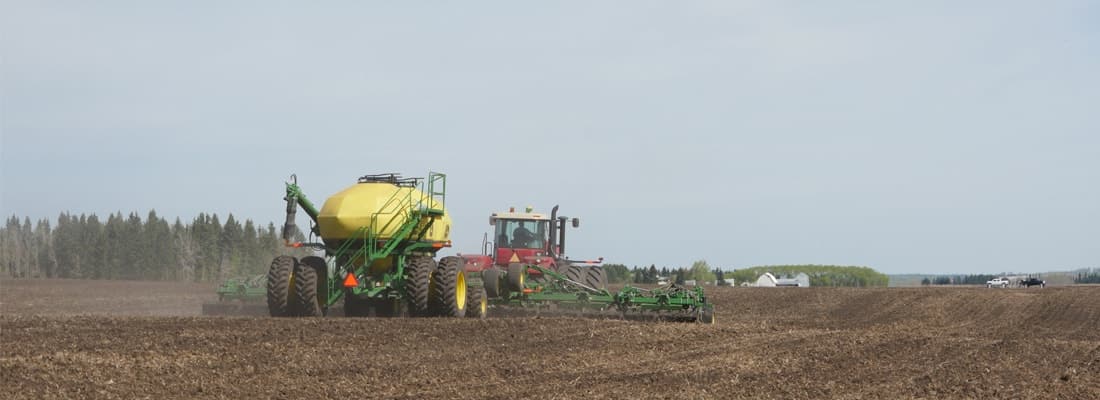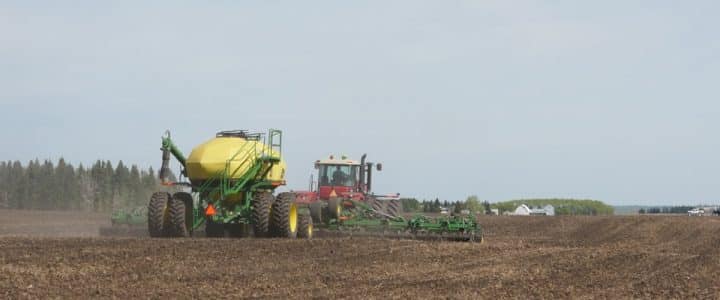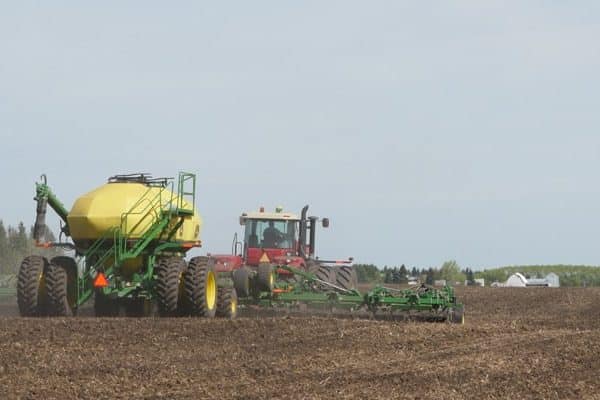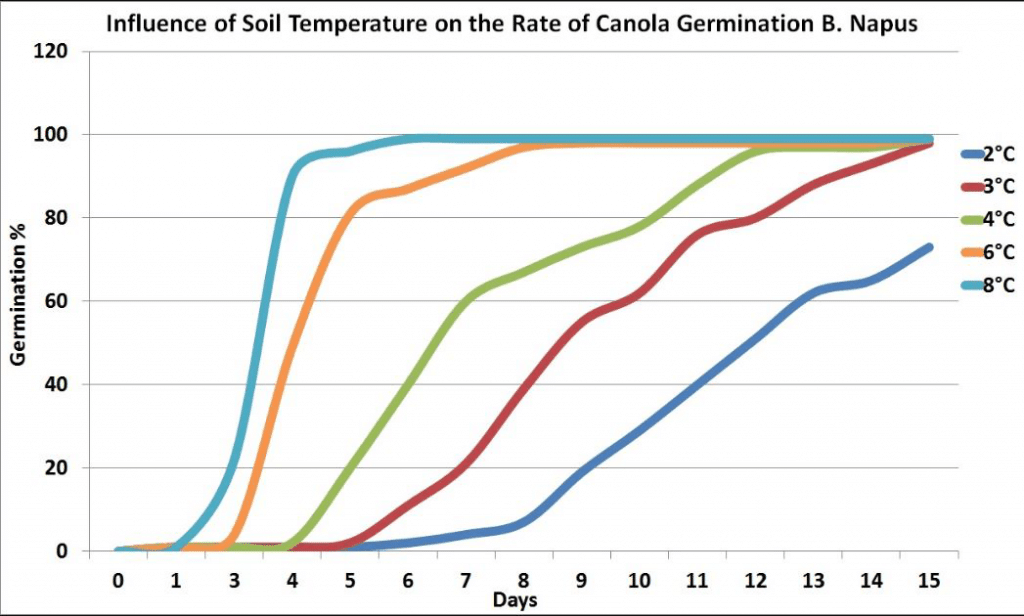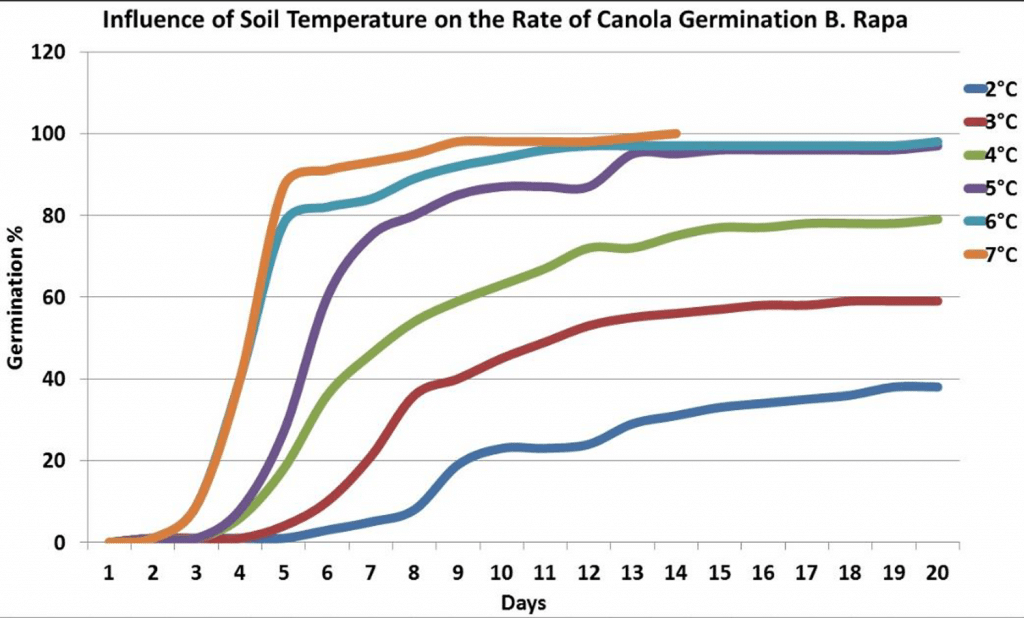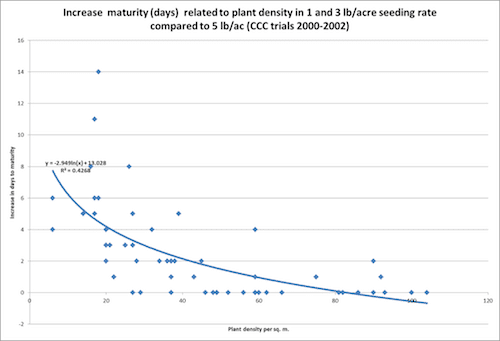Although weather and environmental conditions can have an impact on when a field is seeded, setting at target seeding date for a canola crop can be chosen by the grower. In making this decision there are many factors to consider and the outcomes of seeding date can have a varying impact on seed yield, quality and potentially even next year’s crop.
Important tips for best management
- Early-seeded canola crops tend to produce higher yield and quality. These crops tend to flower before the peak summer heat which can lead to flower blast and pod abortion. Maturing earlier in the fall can also help mitigate damage from frost or other stresses that cause premature senescence and quality downgrading.
- Cold soil temperatures following seeding can delay emergence and increase seedling mortality, sometimes offsetting the benefits of earlier planting. Plan to seed canola when soil temperatures are at least five degrees Celsius with warmer weather in the forecast for reasonably good rates of emergence. However, from the second week of May onward growers may need to take advantage of good field conditions for seeding regardless of temperatures.
- Since canola emerges more slowly in cold soils, the protection from seed treatments may decline before the crop has outgrown its most susceptible phase in these conditions. With early-seeded canola, be ready to apply an insecticide to control early season flea beetles if necessary. Earlier control of weeds may also be necessary, especially for perennials and winter annuals that are better adapted for growing under cold conditions.
- Seeding into cold soils increases the need for management techniques that reduce stress on emerging seedlings. These techniques can include seeding shallow, some seed-placed phosphate to get the “pop up effect,” uniform seed placement, early weed control, and proper crop residue management to allow the soil to warm as quickly as possible. Growers may want to increase seeding rate to offset the potential for lower seed survival in cool soils.
Seed timing factors and impacts
The yield advantage for early seeding — with all else being equal — can be significant. Seeding early, providing that crop conditions allow for it, is a relatively low cost way to increase yield and profit from the crop 1,2,3,4,5,6.
In general, seeding could be considered early from late April to mid-May, but this varies by region. In the southern Prairies, early seeding usually allows the crop to utilize winter and early spring moisture more effectively and may help the crop avoid the highest summer temperatures during flowering. Early season moisture from snow melt can be critical to facilitate the shallow seed placement required for maximum emergence and good seedling establishment and growth. Missing this early season moisture forces the crop to rely more heavily on subsequent rains throughout the season.
Optimum canola seeding dates in Ontario are usually in late April to early May, which is slightly earlier than western Canada. Significant yield reductions occur if seeding is delayed after mid-May, mostly because the crop is flowering during the hot and frequently dry weather in late June and July.
Seeding some fields early can maximize the amount of acres seeded in the proper seeding date window, rather than having a large amount of acres seeded at the end of the seeding window. In most of western Canada seeding after the third week of May puts canola at higher risk for fall frost losses.
Early seeding increases the risk of stand loss due to lethal spring frosts, but canola seedlings that are slow growing and have hardened off can withstand some early season frost. Early seeding can decrease the risk of yield and quality loss due to fall frost damage. Seeding early may actually reduce the overall frost risk, since spring stands severely damaged by frost still have ample time to recover or to be reseeded.
If soil temperatures are cold during seeding, then other seeding practices (use of treated seed, pedigreed seed, optimizing seed-soil contact, seeding depth and rate at seeding and utilizing proper fertilizer placement) become even more important.
Keep in mind that canola emerges more slowly in cold soils, which means protection provided by seed treatments can decline before the crop has outgrown its most susceptible phase. With early-seeded canola it can be especially important to scout for flea beetles and to be prepared to apply an insecticide if needed. Slow growing canola crops will also be more vulnerable at the seedling stage to weed competition. Earlier control of weeds may be necessary, especially for perennials and winter annuals that are better adapted for growing under cold conditions, and hence more able to compete with the crop under those conditions.
Seeding date is often dictated by factors outside the grower’s control, such as:
- The field being able to support tractor traffic. This depends on the amount of snow and runoff, soil texture, spring precipitation and temperature, slope, and residue. As well, the field has to be dry enough to ensure the canola is not “mudded inSeeding when it is too wet (and there are some muddy conditions). In these instances the field may support the tractor and drill, but the soil will not fill in properly over the furrow and the packers may get muddy and slide. More”. In such cases the field may support the tractor and drill, but soil does not fill in properly over the furrow and packers mud up and slide. Seed placement and seed-to-soil contact suffer, resulting in inconsistent seed depth and uneven emergence.
- Pre-seed herbicide applications to control winter annuals and cool-season weeds may push back seeding dates, especially since growers want to make sure weather is warm to ensure good herbicide uptake. When seeding without pre-seed weed control, a post-seeding/pre-emergent or early in-crop application will be necessary.
Soil temperature considerations
Soil temperature has a significant influence on the rate of canola germination and emergence. Canola can germinate at temperatures as low as two to three degrees Celsius, but germination rates are lower and slower at these temperatures, with seeds germinating over a period of weeks. At six degrees Celsius close to 100 per cent germination can occur within eight days 7.
There is more to seeding date selection than just current soil temperatures. Soils may be warm and workable in late March or early April in some regions and years, only to face a month-long cold snap and a foot of snow. Before seeding, consider the probability of severe or sustained cold weather after seeding.
However, if soil temperatures are only one degree Celsius in early May and weather is predicted to stay cool, some growers may decide to seed anyway because good seeding days can be rare some years, and by early May warm temperatures are expected. Other growers will hold out for warmer soils, knowing canola will emerge more rapidly and vigorously. However, by mid-May or later, growers may need to take advantage of good field conditions to get canola in the ground regardless of soil temperature. By that time chances are good that soil temperatures will warm up following planting, even if they are cold at the time of seeding. The greatest yield penalties from planting late have typically resulted from seeding in last week of May or early June.
Spring seeding
Seeding in late April is fairly common in the Brown and Dark Brown soil zones, and has been tried in Black and Grey Wooded zones. Canola seeded at this time faces higher risks from early insect infestations, seedling disease pressures, water ponding, soil crusting, frost damage, and slow emergence due to cold soil. But under the right conditions, seeding in late April can provide an added yield benefit over May seeding 8.
April-seeded canola is likely to have higher seedling mortality but the plants that survive should have more time to branch out and compensate for a thinner stand.
When seeding dates are drastically delayed (usually due to prolonged periods of unfavorable weather conditions), growers may consider broadcast seeding.
Table 1. Seeding date effect on canola maturity at two locations
| wdt_ID | wdt_created_by | wdt_created_at | wdt_last_edited_by | wdt_last_edited_at | Seeding Date | Average Days to Maturity – Brassica napusAlso referred to as Argentine canola, it is the species of canola currently commonly grown in Canada. More – Edmonton | Average Days to Maturity – Brassica napusAlso referred to as Argentine canola, it is the species of canola currently commonly grown in Canada. More – Brandon | Average Days to Maturity – Brassica rapaAlso referred to as Polish canola, it is the less commonly grown species of canola currently grown in Canada. More – Edmonton | Average Days to Maturity – Brassica rapaAlso referred to as Polish canola, it is the less commonly grown species of canola currently grown in Canada. More – Brandon |
|---|---|---|---|---|---|---|---|---|---|
| 1 | ctraweger | 30/04/2024 01:50 PM | ctraweger | 30/04/2024 01:50 PM | 1-May | 120 | 105 | 98 | 90 |
| 2 | ctraweger | 30/04/2024 01:50 PM | ctraweger | 30/04/2024 01:50 PM | 7-May | 123 | 103 | 94 | 85 |
| 3 | ctraweger | 30/04/2024 01:50 PM | ctraweger | 30/04/2024 01:50 PM | 15-May | 123 | 100 | 90 | 70 |
| 4 | ctraweger | 30/04/2024 01:50 PM | ctraweger | 30/04/2024 01:50 PM | 21-May | 120 | 94 | 89 | 73 |
| 5 | ctraweger | 30/04/2024 01:50 PM | ctraweger | 30/04/2024 01:50 PM | 30-May | 113 | 90 | 89 | 70 |
| 6 | ctraweger | 30/04/2024 01:50 PM | ctraweger | 30/04/2024 01:50 PM | 7-Jun | 108 | 86 | 87 | 70 |
| 7 | ctraweger | 30/04/2024 01:50 PM | ctraweger | 30/04/2024 01:50 PM | 12-Jun | 101 | 81 | 85 | 69 |
Source: Data from Manitoba Agricultural Services Corporation and Agriculture Financial Services Corporation
Table 2. Range of seeding and swathing dates at two locations
Source: Data from Manitoba Agricultural Services Corporation and Agriculture Financial Services Corporation
Fall seeding
Canola seeded in early spring yields equal to or better than fall-seeded canola (spring type canola seed planted late enough in fall that cold soil prevents germination until the following spring) 9,10. With the high value of canola seed, growers are less inclined to take a risk on fall seeding when early spring seeding provides similar or superior yield potential. Fall seeding of canola in Western Canada is not a recommended practice.
Crop insurance for spring canola varieties seeded in the fall is available only after inspection in the spring. If the crop is established to the satisfaction of the provincial insurance provider, the crop can be insured as though it were a spring-seeded crop. Winterkill coverage is not available in Alberta, Saskatchewan or Manitoba.
Winter canola seeded in the fall is common practice among canola growers in southern Ontario, but the winter hardiness of these varieties is still inadequate for use on the Prairies. Fall seeding of spring varieties is risky, even in southern Ontario. Any warm temperatures after seeding may lead to premature germination of dormant seeded canola. Spring freeze and thaw cycles can also greatly reduce seed soundness and germination rates. Growers may want to increase the seeding rate (or maybe even double the rate) to attempt to compensate for the high risk seed environment.
If considering fall seeding (which is not a recommended practice in Western Canada):
- Avoid fields with many low spots that flood in the spring or windswept slopes with insufficient residue.
- Avoid summerfallow or fields that were heavily worked in the fall, which tend to have more spring crusting problems that will reduce emergence. They also tend to trap less snow and have earlier snow melt, leading to earlier germination and emergence in spring and greater potential for spring frost damage.
- Try it on small fields first, or split a field to allow comparison to spring seeding under similar field conditions.
- Seed just prior to freeze-up.
- Seed-to-soil contact must be obtained, and try to retain surface residue to prevent spring crusting. However, the residue must be spread evenly.
- Seed shallow at one to two centimetres (roughly 0.5 to 0.75 of an inch) and avoid leaving furrows that fill in over winter, increasing the actual seed depth.
- Avoid broadcasting seed, which tends to increase mortality on the surface. Use typical rates of good quality seed. Fall banding of the fertilizer usually provides the best efficiency and yield response.
Not all canola can be seeded the first weeks of May due to crop conditions or logistics of a large farm operation. With late May or early June seeding, the risk of fall frost halting maturity and reducing yield and quality rises, as does the risk of flower blast during the heat of summer. But canola seeded in late May or early June can still produce good quality and yields under favorable conditions.
Seed shallow and conserve moisture to ensure rapid emergence of a dense and uniform stand. This will minimize days to maturity. Keep in mind that later seeding tends to reduce the estimated days to maturity for a canola varietyA variety is a variant of a species that evolved in nature without the intervention of humans, e.g. Brassica oleracea variety (in short form, var.) botrytis (cauliflower), var. capitata (cabbage), var. italica (broccoli), etc. More, as illustrated in Table 1 with research from Edmonton, Alberta and Brandon, Manitoba. This reduction in maturity is often about half of the delay in seeding. For example, if seeding is 14 days later than optimal, a varietyA variety is a variant of a species that evolved in nature without the intervention of humans, e.g. Brassica oleracea variety (in short form, var.) botrytis (cauliflower), var. capitata (cabbage), var. italica (broccoli), etc. More rated to mature in 100 days may actually mature in 93 days.
Seeding Brassica rapaAlso referred to as Polish canola, it is the less commonly grown species of canola currently grown in Canada. More
B. rapaAlso referred to as Polish canola, it is the less commonly grown species of canola currently grown in Canada. More (Polish canola) requires a shorter growing season than B. napusAlso referred to as Argentine canola, it is the species of canola currently commonly grown in Canada. More, and the relationship between early seeding and higher yield is not as strong for B. rapaAlso referred to as Polish canola, it is the less commonly grown species of canola currently grown in Canada. More as it is for B. napusAlso referred to as Argentine canola, it is the species of canola currently commonly grown in Canada. More. However, early seeding is still preferable for B. rapaAlso referred to as Polish canola, it is the less commonly grown species of canola currently grown in Canada. More to increase the chance of avoiding mid-summer heat stress and to ensure an early harvest.
Plant population effects
Canola seeded early into cool soils will often have lower seedling survival. The following steps can improve survival rates for early-seeded canola:
- Seed as soon as frost risk for the area has declined. Canola can tolerate some frost damage, but there are limits to what the crop will withstand. If frost destroys the growing points of the canola seedlings, the plants will die and re-seeding may be necessary. Frost damage can also be greater in minimum or zero-tillage situations with heavy residue issues, since the soil is often cooler and less able to buffer cold air temperatures.
- Temperatures in the seed zone should average at least four to five degrees Celsius when measured over a three-day period. Take temperatures twice a day; once at 8:00 a.m. and again at 4:00 p.m., and take the three-day average to determine general soil temperature. This is most important for very early seeding dates, when the odds that cool temperatures may continue following planting are highest. Canola can emerge in soils as cool as two to three degrees Celsius, but seedling mortality will be higher and seedling emergence will be spread over more days.
- Plan your seeding date based on the maturity of the varietyA variety is a variant of a species that evolved in nature without the intervention of humans, e.g. Brassica oleracea variety (in short form, var.) botrytis (cauliflower), var. capitata (cabbage), var. italica (broccoli), etc. More. While seeding as soon as possible will reduce the risk of fall frost damage for any varietyA variety is a variant of a species that evolved in nature without the intervention of humans, e.g. Brassica oleracea variety (in short form, var.) botrytis (cauliflower), var. capitata (cabbage), var. italica (broccoli), etc. More, early seeding may be more critical for varieties that need a longer season to mature.
- Be prepared to initiate weed, disease and insect control early. Late applications of these inputs may erase any potential gains from earlier seeding. Threshold levels may need to be lowered if early-seeded canola is slow growing or if plant stands are reduced.
- Consider using phosphate in the seed row to help with pop up. At a rate of only 10 kilograms per hectare, remember that granule or droplet spacing will be fairly wide down the row, so seeds may not have equal access to the fertilizer. A higher rate will improve access for all seeds, but avoid excessive rates that will lead to increased seedling mortality.
- Target an optimum seeding depth of 1.25 to three centimetres (½ – 1 ¼ inches).
- Seed slower to ensure precise seed placement.
Effect on quality
Early-seeded canola tends to produce higher oil content and grade 5,11. Early seeding also leads to an earlier harvest, which reduces the risk for higher chlorophyll content in the seed and oil.
Oil from early-seeded canola tends to have lower saturated fat content. As a result, unsaturated fatty acid levels rise — but the shift is not consistent for all unsaturated fatty acids. Oleic acid increases with early seeding while linoleic and linolenic acids decrease.
Time of seeding does not significantly affect the erucic acid or glucosinolates content of canola. In years with hot, dry weather in late summer, early seeding can result in lower free fatty acids than later seeding.
Oil and protein content often have an inverse relationship. Therefore, early seeded canola tends to have lower protein.
Tips to help late-seeded canola mature faster
Canola stands with fewer than 40 plants per square metre (four plants per square foot) can take four to six more days to mature. Consider the following tips to help canola mature in a timely manner.
Start with a look at the average date of first fall frost. This will indicate how much growing season (on average) is left. Alberta Saskatchewan Manitoba maps show average dates for first fall frost. Alberta frost probabilities are available for each station on Alberta’s AgroClimatic Information Service (ACIS). Most fall frosts occur within two weeks on either side of the average date for each area. For example, if the first fall frost is between August 31 and September 6, on average, then a varietyA variety is a variant of a species that evolved in nature without the intervention of humans, e.g. Brassica oleracea variety (in short form, var.) botrytis (cauliflower), var. capitata (cabbage), var. italica (broccoli), etc. More with 100 days to maturity should be seeded this week to be on the lower risk side for fall frost damage.
Choose an earlier-maturing varietyA variety is a variant of a species that evolved in nature without the intervention of humans, e.g. Brassica oleracea variety (in short form, var.) botrytis (cauliflower), var. capitata (cabbage), var. italica (broccoli), etc. More. Switching from a long-season B. napusAlso referred to as Argentine canola, it is the species of canola currently commonly grown in Canada. More (Argentine) varietyA variety is a variant of a species that evolved in nature without the intervention of humans, e.g. Brassica oleracea variety (in short form, var.) botrytis (cauliflower), var. capitata (cabbage), var. italica (broccoli), etc. More to an early-season B. napusAlso referred to as Argentine canola, it is the species of canola currently commonly grown in Canada. More can gain a week. Switching to a B. rapaAlso referred to as Polish canola, it is the less commonly grown species of canola currently grown in Canada. More (Polish) varietyA variety is a variant of a species that evolved in nature without the intervention of humans, e.g. Brassica oleracea variety (in short form, var.) botrytis (cauliflower), var. capitata (cabbage), var. italica (broccoli), etc. More can gain two weeks. If yield potential for Argentine canola is greatly reduced, growing a Polish varietyA variety is a variant of a species that evolved in nature without the intervention of humans, e.g. Brassica oleracea variety (in short form, var.) botrytis (cauliflower), var. capitata (cabbage), var. italica (broccoli), etc. More may be more economical. But consider that yield potential for Polish is lower and that without herbicide tolerance, weed control can be more difficult. Controlling volunteer canola before seeding is especially important if choosing a Polish canola varietyA variety is a variant of a species that evolved in nature without the intervention of humans, e.g. Brassica oleracea variety (in short form, var.) botrytis (cauliflower), var. capitata (cabbage), var. italica (broccoli), etc. More. To find earlier-maturing Argentine varieties, use the Canola Performance Trials online tool. Search by days to maturity, yield or other priorities like disease resistance.
Growing degree days (GDD). GDDs are calculated by averaging daily maximum and daily minimum temperatures for each day, and subtracting the assumed minimum temperature (in this case base zero) required for growth to proceed. A day with a high of 20 degrees Celsius and a low of 10 degrees Celsius would contribute 15 GDDs on a scale with base of zero.
Carefully consider reseeding decisions. A 2010-12 re-seeding study at Western Applied Research Corporation (WARC) in Scott, Saskatchewan found that 12:
- Reseeding to the same full-season varietyA variety is a variant of a species that evolved in nature without the intervention of humans, e.g. Brassica oleracea variety (in short form, var.) botrytis (cauliflower), var. capitata (cabbage), var. italica (broccoli), etc. More in early June resulted in significantly higher yields at 50 per cent of sites compared to the low plant population control (fewer than four plants per square foot) seeded in the middle of May.
- Reseeding in early June to a slightly shorter season varietyA variety is a variant of a species that evolved in nature without the intervention of humans, e.g. Brassica oleracea variety (in short form, var.) botrytis (cauliflower), var. capitata (cabbage), var. italica (broccoli), etc. More (9350RR) resulted in higher yields than the earlier-seeded low population control at only 25 per cent of site years.
- Reseeding to Polish canola was not economical compared to reseeding to an Argentine varietyA variety is a variant of a species that evolved in nature without the intervention of humans, e.g. Brassica oleracea variety (in short form, var.) botrytis (cauliflower), var. capitata (cabbage), var. italica (broccoli), etc. More.
- Reseeding in the middle of June was not economical 13.
Seed shallow. This is especially important later in the spring.
Increase the seeding rate. A higher rate means a more dense stand, which means less branching and overall earlier maturity.
Use seed-placed phosphate fertilizer. Pop-up phosphate fertilizer applied with the seed can slightly impact maturity, but this effect will be diminished by warmer soil temperatures and higher soil P levels.
Reduce nitrogen rates. Lower nitrogen availability means the crop will not be vegetative for as long, which means the crop may mature slightly earlier.
Consider the profit potential of other crops. Yield potential for all crops drops with late seeding. For example, calculate if a lower yielding canola crop would provide a better return than a lower yielding wheat or barley crop.
Footnotes
- Manitoba Agricultural Services Corporation data from1998-2008[↩]
- AFSC Alberta crop insurance data for 2001-10[↩]
- Kondra, Z.P. 1977. Effects of planted date on rapeseed. Can. J. Plant Sci., 57, 607-609.[↩]
- Degenhardt, D.F., & Kondra, Z.P.1981. The influence of seeding date and seeding rate on seed yield and yield components of five genotypes of Brassica napusAlso referred to as Argentine canola, it is the species of canola currently commonly grown in Canada. More. Can J. Plant Sci., 61, 175-183.[↩]
- Kirkland, K.J., & Johnson, E.N. 2000. Alternative seeding dates (fall and April) affect Brassica napusAlso referred to as Argentine canola, it is the species of canola currently commonly grown in Canada. More canola yield and Canadian Journal of Plant Science quality, 80(4) 713-719.[↩][↩]
- Canola Council of Canada Canola Production Centre trials in the late 1990s[↩]
- Mills, P.F. The effects of low temperature on the germination and emergence of canola. Agriculture and Agri-Food CanadaAgriculture and Agri-Food Canada is a department of the Government of Canada. More, Beaverlodge, Alta. Final report to the Alberta Agriculture Farming for the Future project 83-0036.[↩]
- Kirkland, K.J., & Johnson, E.N. 2000. Alternative seeding dates (fall and April) affect Brassica napusAlso referred to as Argentine canola, it is the species of canola currently commonly grown in Canada. More canola yield and Canadian Journal of Plant Science quality, 80(4) 713-719.[↩]
- Kirkland, K.J., & Johnson, E.N. 2000. Alternative seeding dates (fall and April) affect Brassica napusAlso referred to as Argentine canola, it is the species of canola currently commonly grown in Canada. More canola yield and Canadian Journal of Plant Science quality, 80(4) 713-719.[↩]
- Clayton, G. W., Harker, K. N., O’Donovan J. T., Blackshaw, R. E., Dosdall, L. M., Stevenson, F. C., & Ferguson, T. 2004. Fall and spring seeding date effects on herbicide-tolerant canola (Brassica napusAlso referred to as Argentine canola, it is the species of canola currently commonly grown in Canada. More L.) cultivarsCultivars are variants in a species developed through the intervention of humans (despite the term 'variety' often being incorrectly used to describe this). Cultivars can be open-pollinated type, hybrid, synthetic, composite, etc. More. Can. J. Plant Sci., 84, 419–430.[↩]
- Canola Production Centre trials[↩]
- Kirk, A., Davey, B., Phelps, S., Johnson, E., Shirtliffe, S., Vera, C., Holzapfel, C., & Nybo, B. 2014. Response of canola to low plant populations and evaluation of reseeding options. Canola Agronomic Research Program project (CARP SCDC 2010-7). Retrieved from: www.saskcanola.com/research/response-of-canola-to-low-plant-populations-and-evaluation-of-reseeding-options[↩]
- Kirk, A., Davey, B., Phelps, S., Johnson, E., Shirtliffe, S., Vera, C., Holzapfel, C., & Nybo, B. 2014. Response of canola to low plant populations and evaluation of reseeding options. Canola Agronomic Research Program project (CARP SCDC 2010-7). Retrieved from: www.saskcanola.com/research/response-of-canola-to-low-plant-populations-and-evaluation-of-reseeding-options[↩]
